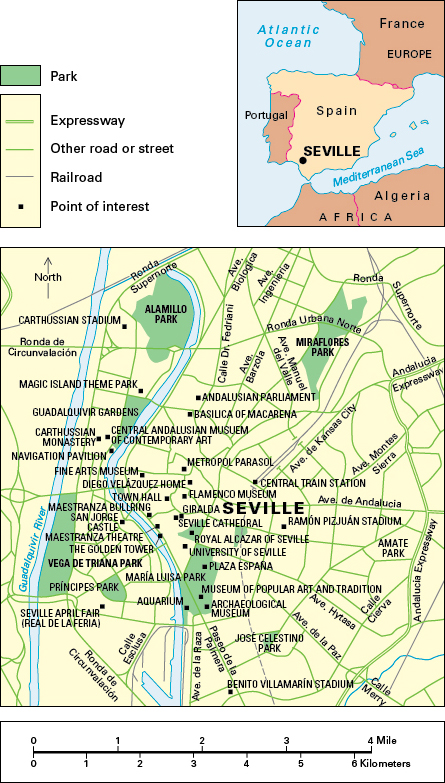Seville, << suh VIHL >> (pop. 684,234), is a city in southern Spain. It is the capital of Seville province. The city’s name also is spelled Sevilla << say VEEL yah >> . Seville is a leading center of Spanish art, literature, and education. Two of Spain’s greatest painters, Diego Velázquez and Bartolomé Murillo, were born in Seville. Many foreign artists have fallen in love with Seville. Two famous operas, Carmen and The Barber of Seville, are set in the city. The University of Seville dates back to 1502.

The city lies 60 miles (97 kilometers) northeast of Cadiz on the Guadalquivir River, in an area of vineyards and wheat plantations. A great wall with 64 towers once surrounded the city, and its remains still stand. Moors, Muslims from northwestern Africa, lived in Seville for hundreds of years. Moorish influence shows in the city’s network of small, shaded streets and in the whitewashed, balconied houses built around courtyards and fountains.
Seville’s greatest building is its cathedral, started in 1402 and finished in 1519. It stands on the site of a Moorish mosque and is one of Europe’s largest church structures. Seville’s emblem is the Giralda, a Muslim minaret (tower) that is part of the city’s cathedral. The Giralda stands over 300 feet (91 meters) high. It was built in the 1100’s.
Seville’s factories produce aviation products, cigars, chocolate, iron products, machinery, perfume, pottery, and silks. Canals and the Guadalquivir River make the city an important inland port. Exports include airplanes, cork, olives and other fruit, wine, and wool.
Seville once was the center of commerce between Spain and its American empire. In 1992, Seville hosted a world’s fair called Expo ’92. It coincided with the 500th anniversary of Christopher Columbus’s first voyage to America.
